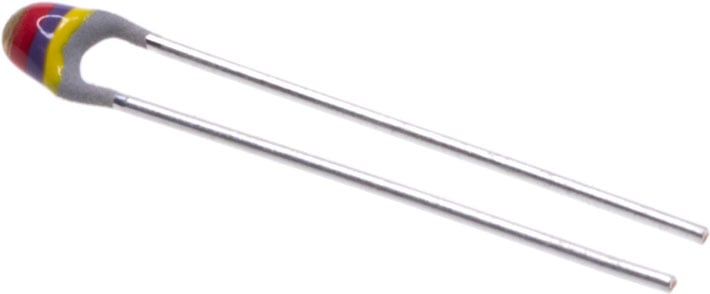What Are Thermistors?
February 9, 2023

You may need thermistors more than you think!
A thermistor is a type of resistor whose resistance is dependent on temperature. This means it reacts differently as the condition changes. It appears in a bead, disk, or cylindrical shape encapsulated with epoxy or glass – made of metallic oxides.
Read on to learn more about thermistors. This post will answer what they are, how they work, and their types and applications.
Thermistors
The term ‘thermistor’ is a combination of “thermal” and “resistor”. A thermistor senses temperature by measuring changes in resistance as the thermal shifts. It serves as an inexpensive yet accurate method for the job.
Thermistors have two terminals connected to a semiconductor. This semiconductor comes with a terminal bridge across it. It has an intrinsic temperature higher than or lower than room temperature. The range usually depends on the base resistance. But it generally operates well within a controlled environment – usually between -20°C and +120°C.
How they work is straightforward. When a thermistor gets exposed to heat or cold, its resistance will change suitably. This behaviour creates electrical signals which can be interpreted. This allows the sensitive component to respond accordingly to changing temperatures.
Thermistors come in a variety of sizes and shapes, including:
- Rod-shaped thermistors
- Disc-shaped thermistors
- Bead-shaped thermistors
- Wire-wound types
- Injection moulded styles and more!
They also require less power. This makes them great choices for battery-powered devices where energy conservation is important. Their small size and low cost also make them highly efficient. Furthermore, switching speeds can be quite fast due to the output voltage signals. These signals respond rapidly when measured against changes in resistance.
Overall, thermistors provide accurate temperature measurements due to their:
- durable construction
- responsive signals
- dual sensitivity design
- low cost, small size and relatively high efficiency.
The Working Principle
Thermistors require a large temperature coefficient resistance change to measure temperature. As a temperature sensor, one is placed in the device’s body and connected to an electrical circuit.
When the temperature in the device changes, the resistance in the thermistor follows. The connected circuit logs the transition. It is also calibrated against the set temperature.
The concept of a thermistor is based on the Steinhart-Hart Coefficient. It is a mathematical method for deriving precise temperature readings.
Types of Thermistors
There are two types of thermistors:
- Negative Temperature Coefficient (NTC)
- Positive Temperature Coefficient (PTC)
Negative Temperature Coefficient (NTC)
NTC thermistors have a negative temperature coefficient, hence the name. This means that when the temperature increases, resistance decreases. NTC thermistors are often used as resistive temperature sensors and current-limiting devices.
They are about five times greater than silicon temperature sensors (silistors). Plus, about ten times greater than resistance temperature detectors (RTDs). NTC sensors are typically used in a range from −25°C to +200°C.
Have a look at these NTC devices below:

NTC Thermistors +/- 5%
They consist of an NTC chip soldered between two tin-plated copper wires. Colour-band-coded with grey base coating.
Other features include
- Accuracy over a wide temperature range
- High stability over a long life
- Excellent price/performance ratio
- With radial mounting
- The operating temperature is -25°C to 125°C
Positive Temperature Coefficient (PTC)
In contrast, PTC thermistors have a positive temperature coefficient, and thus the name. When temperature increases, the resistance increases, and when temperature decreases, resistance decreases.
This type of thermistor is generally used as a fuse. For instance, for self-regulating heating elements. Or for self-resetting over-current protection. The most common switching temperatures are in the range of 60°C to 120°C.
Common Applications of Thermistors
The precise control of temperature is a crucial aspect of many manufacturing processes. Without this, the success or failure of an application is questionable. This is where the thermistors come in, a.k.a. the heart of any temperature-measuring device.
Wherever and whenever temperature needs to be measured, a thermistor is vital. This can include industrial applications or simply home cooking. A common use, for instance, is as a part of HVAC systems, which are responsible for thermal support and airflow.
Other uses are the following:
Cellphone
Cellphones are among the devices that require heating or cooling protection circuits. A thermistor ensures safe operation by detecting heat within the phone and relaying the data to the IC. It also allows electrical components to operate efficiently when there is heat.
IC stands for Integrated Circuits.
Microwave
Every microwave has a thermistor for determining and maintaining the temperature. It also helps prevent the appliance from overheating and catching fire.
Rechargeable batteries
No batteries last forever, but controlling their temperature degradation makes a difference. This is because they produce heat that needs controlling.
Refrigerators
A refrigerator can have five to nine thermistors that monitor the operation. The thermistor collects information on the freezer, evaporator, and refrigerator. It monitors the temperature and sends the collected data to the control board.
In the evaporator, a thermistor is attached to the top of the evaporator coil.
Surge protectors
An electricity overload creates heat, but surge protectors are there to help. Thermistors placed in surge protectors help control surges of energy. As an overload occurs, heat buildup arises. The thermistor identifies the buildup and shuts down the current flow.
Thermostats
A thermostat in an HVAC system monitors the temperature. Its central part is a highly sensitive thermistor.
In the system, the temperature control consists of a simple circuit component. This includes an operational amplifier, thermistor, and relay.
Vehicle thermistor
Another application is in automobiles for oil and coolant. Known as vehicle thermistors, they allow the driver to know if the car is overheating.
The thermistor is connected to the instruments on the dashboard. It gathers necessary information on the efficiency of the vehicle’s operation.
Washing machine
Another home appliance that benefits from thermistors is washing machines. The thermistor determines the ideal temperature for the machine to work. It also makes sure to maintain it for successful washing and drying operations.
The Bottom Line
The biggest perk of thermistors is they can provide a huge change in resistance value. When there is a temperature change, they offer a more sensitive and accurate reading. This makes them crucial in many temperature-measuring devices.
Various thermistors can adapt and configure for different applications. Their multiple types and sizes allow them to be used in any operation, condition, or situation.
© Electrotech Brands Pty Ltd 2023


Write a Comment
You must be logged in to post a comment.